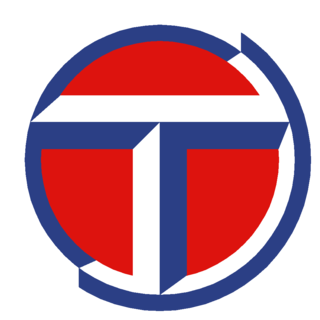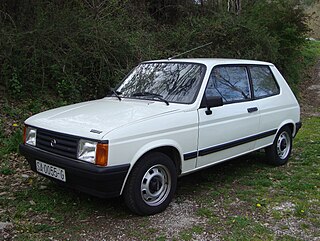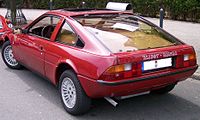
Chappe et Gessalin is the short-form of the name of French coachbuilder "Carrosserie Chappe Frères et Gessalin". The company built automobile bodies and did contract assembly for other automobile manufacturers. It was also the parent of Automobiles CG, a French automobile maker founded in 1966 which built and sold complete cars under its own name.

Simca was a French automaker, founded in November 1934 by Fiat S.p.A. and directed from July 1935 to May 1963 by Italian Henri Pigozzi. Simca was affiliated with Fiat and, after Simca bought Ford's French subsidiary, became increasingly controlled by Chrysler. In 1970, Simca became a brand of Chrysler's European business, ending its period as an independent company. Simca disappeared in 1978, when Chrysler divested its European operations to another French automaker, PSA Peugeot Citroën. PSA replaced the Simca brand with Talbot after a short period when some models were badged as Simca-Talbots.

The Peugeot 205 is a four-passenger, front-engine, supermini (B-segment) car manufactured and marketed by Peugeot over a sixteen-year production run from 1983 to 1999, over a single generation. Developed from Projet M24 and introduced on 25 February 1983, the 205 replaced the Peugeot 104 and the Talbot Samba, using major elements from their design. It won What Car?'s Car of the Year for 1984. It was also declared "car of the decade" by CAR Magazine in 1990. Peugeot stopped marketing the 205 in 1999 in favor of its new front-engined 206. The 106, which was introduced in 1991, effectively took over as Peugeot's smaller front-engined model in their lineup. The 106 was indeed developed as a close sibling of the Citroën AX, sharing many components and a platform that later evolved into the Citroën Saxo.

The Renault Espace is a series of automobiles manufactured by Renault since 1984. For its first five generations, the Espace was a multi-purpose vehicle/MPV (M-segment), but it has been redesigned as a mid-size crossover SUV for its sixth generation.

Talbot is a dormant automobile marque introduced in 1902 by British-French company Clément-Talbot. The founders, Charles Chetwynd-Talbot, 20th Earl of Shrewsbury and Adolphe Clément-Bayard, reduced their financial interests in their Clément-Talbot business during the First World War.

The Talbot Horizon is a compact hatchback designed by Chrysler Europe and produced from 1978 to 1987. It was sold under the Simca, Chrysler and Talbot nameplates. The successor to both the Simca 1100 and Hillman Avenger, the Horizon adopted a front-wheel drive, transverse-engine layout.

The Talbot Tagora is an executive car developed by Chrysler Europe and produced by Peugeot Société Anonyme (PSA). The Tagora was marketed under the Talbot marque after PSA took over Chrysler's European operations in 1979. PSA presented the first production vehicle in 1980 and launched it commercially in 1981. The Tagora fell short of sales expectations, described as a "showroom flop" just a year after its launch, and PSA cancelled the model two years later. Fewer than 20,000 Tagora models were built, all of them at the former Simca factory in Poissy, near Paris, France.

In automotive design, an RMR, or rear mid-engine, rear-wheel-drive layout is one in which the rear wheels are driven by an engine placed with its center of gravity in front of the rear axle, and thus right behind the passenger compartment. Nowadays more frequently called 'RMR', to acknowledge that certain sporty or performance focused front-engined cars are also "mid-engined", by having the main engine mass behind the front axle, RMR layout cars were previously just called MR, or mid-engine, rear-wheel-drive layout), because the nuance between distinctly front-engined vs. front mid-engined cars often remained undiscussed.

A transaxle is a single mechanical device which combines the functions of an automobile's transmission, axle, and differential into one integrated assembly. It can be produced in both manual and automatic versions.

The Talbot Samba is a city car manufactured by the PSA Group in the former Simca factory in Poissy, France, and marketed under the short-lived modern-day Talbot brand from 1981 to 1986. Based on the Peugeot 104, it and the Talbot Express were the only Talbots not inherited from Chrysler Europe, engineered by PSA alone. It was also the last new Talbot car to be launched. Its demise in 1986 was effectively the end of the Talbot brand for passenger cars. Launched initially as a three-door hatchback, it was also for some time the only small car available in a factory-ordered cabrio body style, and the most economical car in Europe.

Chrysler Europe was the American automotive company Chrysler's operations in Europe from 1967 through 1978. It was formed from the merger of the French Simca, British Rootes and Spanish Barreiros companies. In 1978, Chrysler divested these operations to PSA Peugeot Citroën.

The Simca 1100 is a series of French compact family cars – mainly C-segment hatchbacks, but also a compact wagon and popular delivery vans – built for over 15 years by French car-maker Simca, from 1967 through 1982/1985. There was even a very early 'hot hatchback', and a family cross-over: the Matra Simca Rancho. The hatchbacks were replaced by the Simca-Talbot Horizon.

The Simca Poissy engine, commonly known as the Simca 1100 engine, was a four-cylinder overhead valve engine developed by Simca for use in its superminis and economy cars, designed by the engineer Georges Martin. In spite of its common name, the engine actually predates the Simca 1100 model, and debuted in 1961 in the Simca 1000. It was developed and produced by Simca in the late 1960s at the manufacturer's factory in Poissy, hence its name.
The Type 180 was an automobile straight-4 OHC engine produced in the 1970s.

The Matra Bagheera is a sports car built by the automotive division of the French engineering group Matra from 1973 to 1980, in cooperation with automaker Simca. It was marketed as the Matra-Simca Bagheera until its final year of production, when its designation was changed to the Talbot-Matra Bagheera following Chrysler Europe's demise and subsequent takeover by PSA.
France was a pioneer in the automotive industry and is the 11th-largest automobile manufacturer in the world by 2015 unit production and the third-largest in Europe. It had consistently been the 4th-largest from the end of World War II up to 2000. It is 16% of sales of French manufactured products.

The Matra Sports V12 engine is a family of automotive internal combustion engines built for Formula One (F1) and sports car endurance racing. Cars powered by versions of the engine won at the 24 Hours of Le Mans in 1972, 1973, and 1974, and gave Matra the World Championship for Makes title in 1973 and 1974. The Matra Sports V12 is also remembered for its distinctive sound.

The Ligier JS2 is a mid-engined sports coupé that was built by Ligier in the French commune of Abrest near Vichy in the department of Allier between 1971 and 1975. Road-going and competition versions were built.

The Matra-Simca MS630 was a Group 5 prototype race car introduced in 1967 for the World Championship for Makes. The MS630 replaced the previous Matra MS620. The car was initially designated as the Matra M630, but when Simca sponsored Matra in 1969, it was renamed as the Matra-Simca MS630.

The Citroën BX 4TC is a rally car, designed, developed and produced by French manufacturer Citroën; derived from the Citroën BX production car. A road-going, street-legal version was built to meet the requirements of the Group B category of the World Rally Championship. A total of 200 models were produced, as this was the production requirement.



























